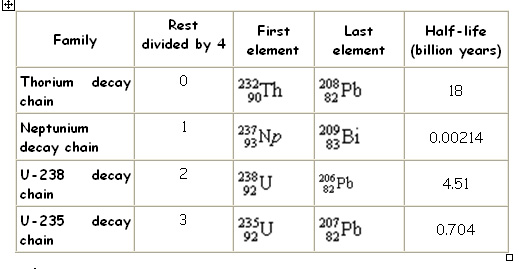|
Radioactive decay chains During the emission of a radiation (with the exception of the gamma decay) a new nucleus (called daughter) is formed. If the new nucleus is still radioactive, the decay process will continue. A series of several successive decays is called radioactive decay chain. Usually alpha- and beta-decays followed by gamma-decays can be found in a radioactive decay chain. Among the different decay modes only the alpha-decay changes the mass number (A) of the nucleus; it is decreased by 4, because a particle with 2 protons and 2 neutrons (4He) is emitted. Therefore four decay chains are distinguished according to the remnant of (A/4). 
The half-life of the first member of the neptunium-chain is shorter than the time since the Earth is existing (4,5 billion years). Therefore, the members of the neptunium-chain have already decayed away, but they can be produced artificially. If would you like to see each decay chain, please click to the name of the chain: Thorium decay chain, Neptunium decay chain, U-238 decay chain, U-235 decay chain
|








